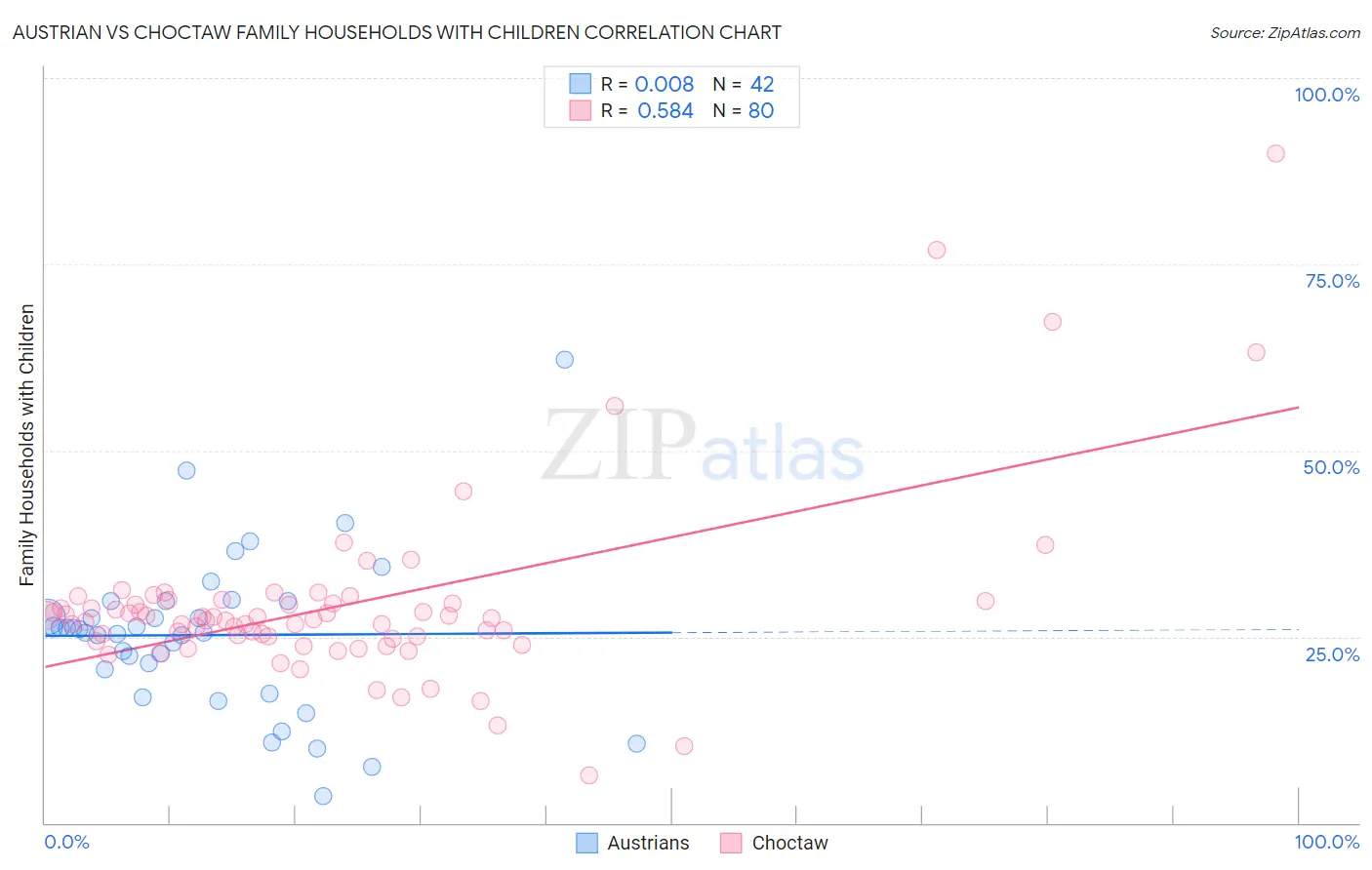Austrian vs Choctaw Family Households with Children
COMPARE
Austrian
Choctaw
Family Households with Children
Family Households with Children Comparison
Austrians
Choctaw
27.1%
FAMILY HOUSEHOLDS WITH CHILDREN
9.9/ 100
METRIC RATING
220th/ 347
METRIC RANK
28.1%
FAMILY HOUSEHOLDS WITH CHILDREN
98.3/ 100
METRIC RATING
105th/ 347
METRIC RANK
Austrian vs Choctaw Family Households with Children Correlation Chart
The statistical analysis conducted on geographies consisting of 451,563,226 people shows no correlation between the proportion of Austrians and percentage of family households with children in the United States with a correlation coefficient (R) of 0.008 and weighted average of 27.1%. Similarly, the statistical analysis conducted on geographies consisting of 269,568,825 people shows a substantial positive correlation between the proportion of Choctaw and percentage of family households with children in the United States with a correlation coefficient (R) of 0.584 and weighted average of 28.1%, a difference of 3.5%.

Family Households with Children Correlation Summary
| Measurement | Austrian | Choctaw |
| Minimum | 3.6% | 6.5% |
| Maximum | 62.3% | 89.9% |
| Range | 58.6% | 83.4% |
| Mean | 25.2% | 29.2% |
| Median | 25.9% | 27.4% |
| Interquartile 25% (IQ1) | 20.7% | 24.9% |
| Interquartile 75% (IQ3) | 29.7% | 29.6% |
| Interquartile Range (IQR) | 9.1% | 4.7% |
| Standard Deviation (Sample) | 10.6% | 12.4% |
| Standard Deviation (Population) | 10.4% | 12.3% |
Similar Demographics by Family Households with Children
Demographics Similar to Austrians by Family Households with Children
In terms of family households with children, the demographic groups most similar to Austrians are New Zealander (27.1%, a difference of 0.020%), Paraguayan (27.1%, a difference of 0.030%), Immigrants from Japan (27.1%, a difference of 0.050%), Pima (27.1%, a difference of 0.050%), and German (27.1%, a difference of 0.080%).
| Demographics | Rating | Rank | Family Households with Children |
| Okinawans | 13.7 /100 | #213 | Poor 27.2% |
| Africans | 13.0 /100 | #214 | Poor 27.2% |
| Northern Europeans | 12.8 /100 | #215 | Poor 27.2% |
| Cubans | 12.2 /100 | #216 | Poor 27.1% |
| U.S. Virgin Islanders | 12.1 /100 | #217 | Poor 27.1% |
| Greeks | 11.4 /100 | #218 | Poor 27.1% |
| Immigrants | Japan | 10.7 /100 | #219 | Poor 27.1% |
| Austrians | 9.9 /100 | #220 | Tragic 27.1% |
| New Zealanders | 9.6 /100 | #221 | Tragic 27.1% |
| Paraguayans | 9.4 /100 | #222 | Tragic 27.1% |
| Pima | 9.2 /100 | #223 | Tragic 27.1% |
| Germans | 8.7 /100 | #224 | Tragic 27.1% |
| Canadians | 7.5 /100 | #225 | Tragic 27.1% |
| Czechoslovakians | 6.6 /100 | #226 | Tragic 27.0% |
| Tsimshian | 6.6 /100 | #227 | Tragic 27.0% |
Demographics Similar to Choctaw by Family Households with Children
In terms of family households with children, the demographic groups most similar to Choctaw are Sioux (28.1%, a difference of 0.0%), Palestinian (28.1%, a difference of 0.050%), Immigrants from South America (28.0%, a difference of 0.10%), Assyrian/Chaldean/Syriac (28.1%, a difference of 0.15%), and Immigrants from Uganda (28.0%, a difference of 0.17%).
| Demographics | Rating | Rank | Family Households with Children |
| Immigrants | Kenya | 98.9 /100 | #98 | Exceptional 28.1% |
| Immigrants | Azores | 98.8 /100 | #99 | Exceptional 28.1% |
| Indonesians | 98.8 /100 | #100 | Exceptional 28.1% |
| Immigrants | Oceania | 98.8 /100 | #101 | Exceptional 28.1% |
| Assyrians/Chaldeans/Syriacs | 98.7 /100 | #102 | Exceptional 28.1% |
| Palestinians | 98.5 /100 | #103 | Exceptional 28.1% |
| Sioux | 98.3 /100 | #104 | Exceptional 28.1% |
| Choctaw | 98.3 /100 | #105 | Exceptional 28.1% |
| Immigrants | South America | 98.0 /100 | #106 | Exceptional 28.0% |
| Immigrants | Uganda | 97.7 /100 | #107 | Exceptional 28.0% |
| Immigrants | Burma/Myanmar | 97.7 /100 | #108 | Exceptional 28.0% |
| Tohono O'odham | 97.6 /100 | #109 | Exceptional 28.0% |
| Spaniards | 97.4 /100 | #110 | Exceptional 28.0% |
| Scandinavians | 97.1 /100 | #111 | Exceptional 28.0% |
| Immigrants | Middle Africa | 97.0 /100 | #112 | Exceptional 28.0% |